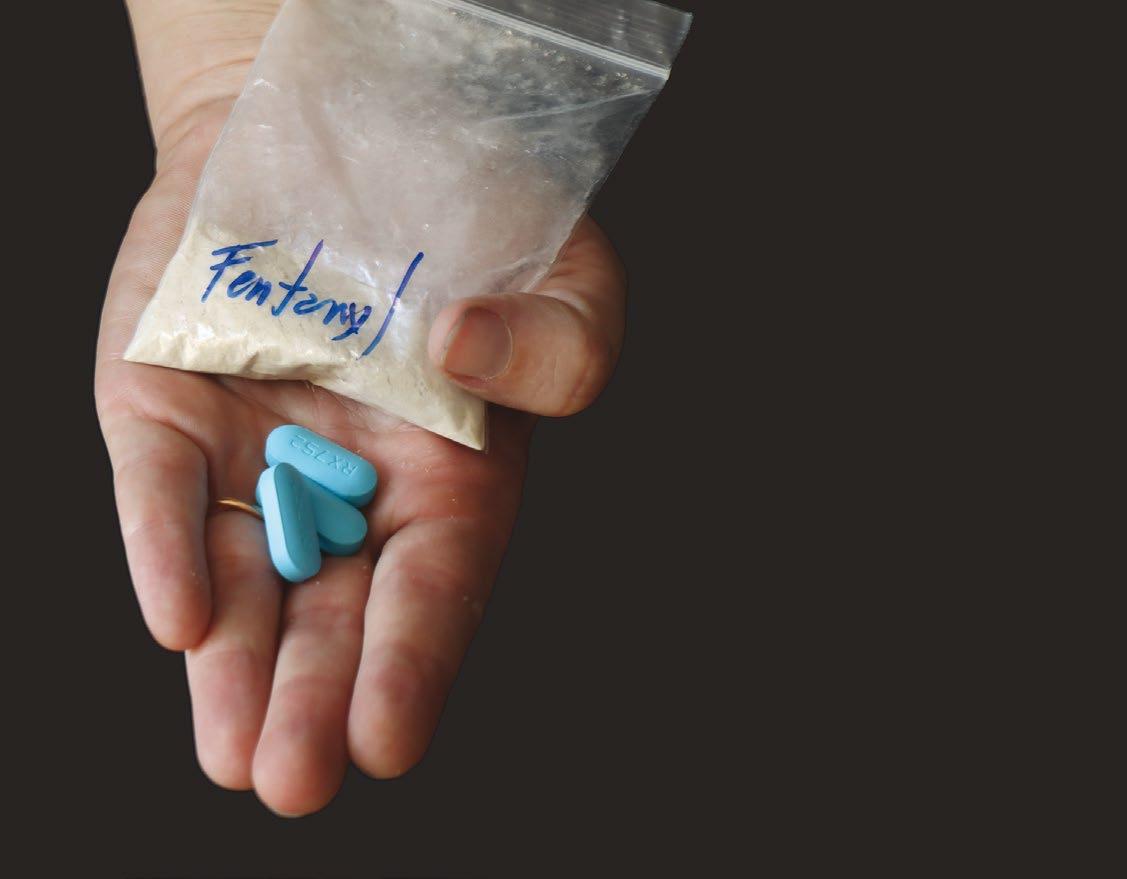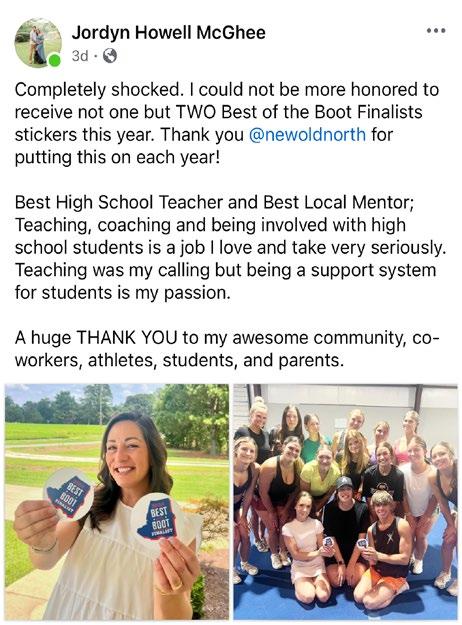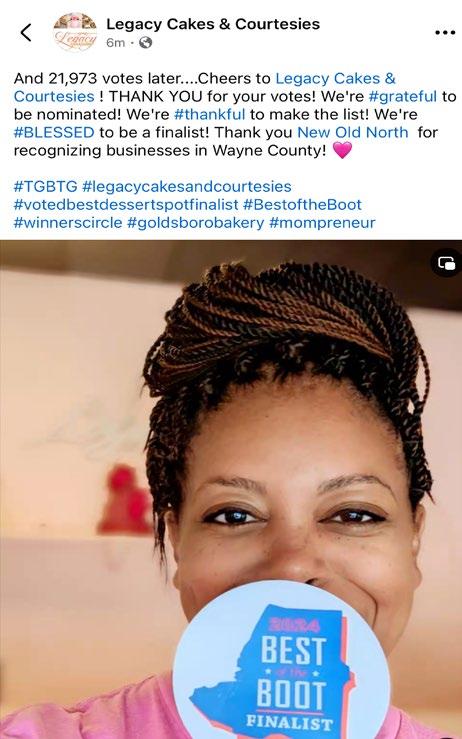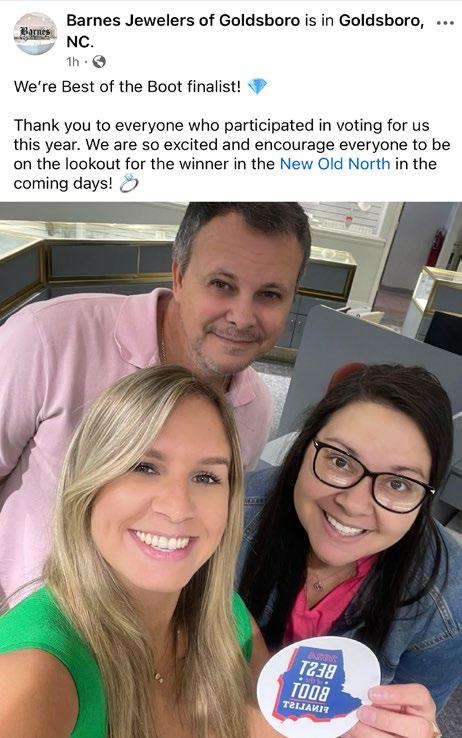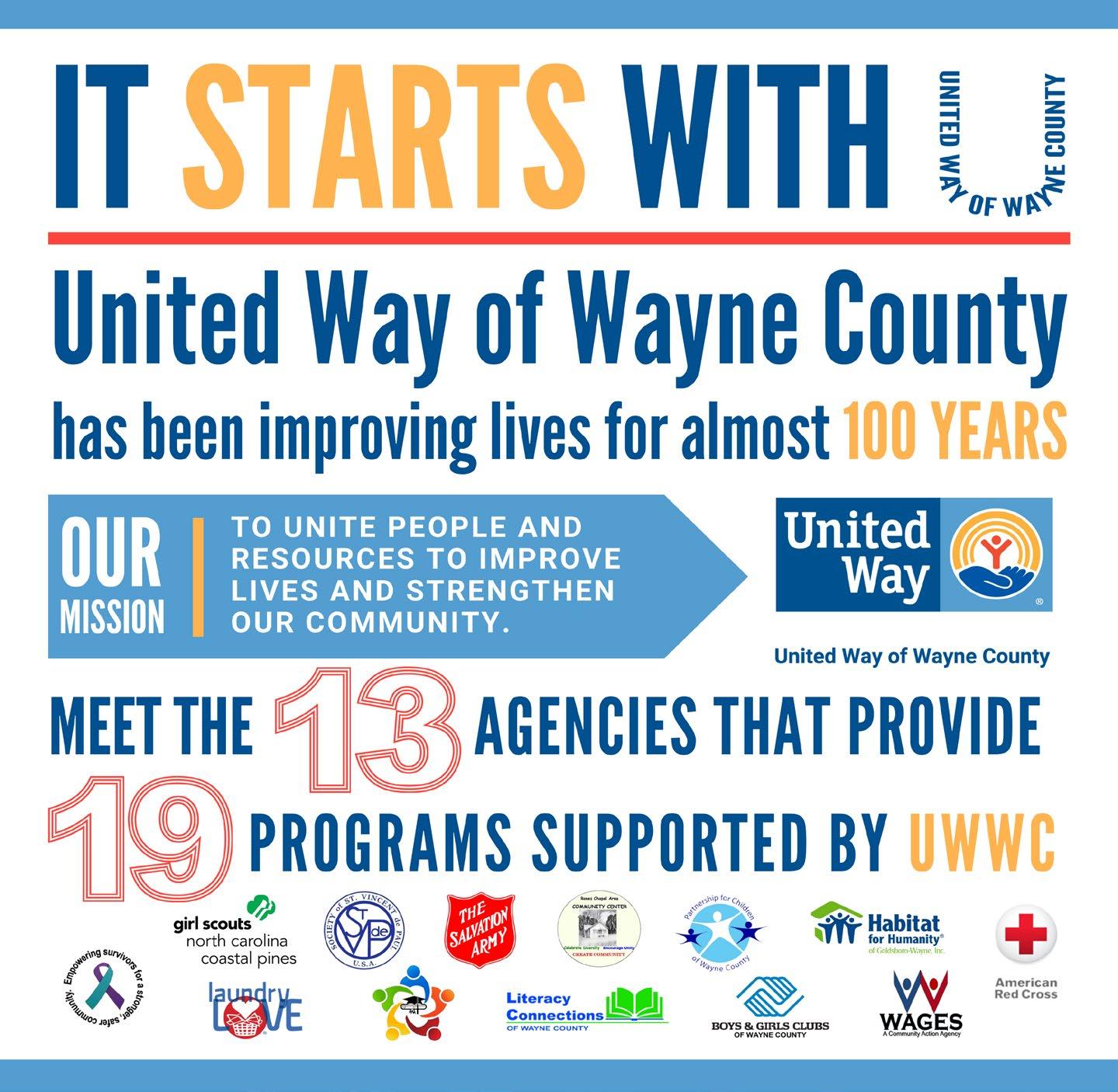Opioid settlement benefits Wayne County
When it’s all said and done, the local government will have received more than $11 million as a result of landmark deal between state attorneys general and pharmaceutical distributors and manufacturers.
Aportion of a landmark settlement reached between pharmaceutical giants and state attorneys general that was announced in July 2021 has made its way to Wayne County coffers — allowing the local government to invest millions of dollars in the fight against opioid addiction.
And while the total sum — more than $11.3 million — will not be fully realized until the 2038-39 fiscal year, County Commissioners recently approved $1,716,071 in spending for programs the board believes will aid in supporting what Attorney General Josh Stein characterized as “much-needed treatment and recovery services” in the wake of the nation’s opioid epidemic.
The 2021 agreement resolved the claims of state and local governments across the U.S. — including nearly 4,000 that had filed lawsuits against Cardinal, McKesson, and AmerisourceBergen, the nation’s three major pharmaceutical distributors, and Johnson & Johnson, which manufactured and marketed opioids — and will ultimately see a more than $750 million impact in North Carolina.
Here is where Wayne’s recently appropriated $1.7 million is going. The descriptions of services have been taken directly from county documents and have not been edited for spelling or grammar:
• Wayne County Sheriff’s Office, $525,000: The Wayne County Detention Center Substance Misuse Program will provide treatment for incarcerated individuals by connecting them with essential providers, classes, and services essential for maintaining sobriety post-release.
• Wayne County Public Schools, $410,000: WCPS will provide a layered approach to programs, services, and training to encourage early identification and intervention for children or adolescents who may be struggling with problematic use of drugs or mental health conditions. In addition, WCPS will install vape sensors in restrooms and locker rooms to detect the use of THC and other dangerous chemicals or organic products. This will be used in con-
junction with a counseling-based “alternative-to-suspension” cessation program for first-time offenders.
• Wayne Coalition for Addiction and Life Management (CALM), $50,000: Wayne County Coalition for Addiction and Life Management, Inc., a registered non-profit, will provide support to successfully guide individuals and/or families suffering due to substance use disorder through the complex re-
sources needed to achieve holistic recovery. CALM will bridge the service gaps and support healthy, drugfree communities.
• Wayne County Day Reporting Center, $150,000: The Wayne County Day Reporting Center is a Department of Wayne County that offers pretrial release supervision to those awaiting trial. Clients are able to avoid pretrial confinement in the Wayne County Detention Center as long as they comply
OPIOID PAYMENT BREAKDOWN
The following is an 18-year schedule of estimated payments to Wayne County from national opioid settlements. The amounts were provided by the North Carolina Department of Justice:
with the terms of their pretrial supervision. The Center will provide an opportunity to help curb opioid and other drug use in Wayne County by assisting clients with achieving housing stability and drug treatment. With stable housing and drug-free status, participants will have increased employability, resulting in food security and health improvements through adequate insurance coverage. Continued on page 6
Continued from page 4
• Goldsboro Comprehensive Treatment Center, $50,000: Will provide Medication-Assisted Treatment (MAT) to underinsured or uninsured residents of Wayne County who would otherwise be unable to start or stay in treatment. ATS specializes in treating individuals diagnosed with Opioid Use Disorder (OUD). The facility offers all three FDA-approved OUD medications, including Methadone, Buprenorphine, Buprenorphine/Naloxone, Sublocade, and Vivitrol, tailoring treatment to each individual’s recovery needs. ATS will also provide financial assistance to bridge gaps in covering balances when insurance falls short. This support continues until insurance coverage is reinstated or financial status improves, serving as a last resort for funding.
• Hope Center Ministries, $97,988: Hope Center Ministries is a non-profit corporation which provides recovery services to individuals with substance abuse addictions. The organization will hire an employee who will act as a full-time peer support specialist for the program. This employee will ensure the men in the Goldsboro Men’s Center are receiving the best care possible while in the program, including dealing with any major health concerns, placing them with the right Vocational Training Provider once
This settlement will force these drug companies to pay an historic amount of money to bring much-needed treatment and recovery services to North Carolina.
they advance to Phase 2 of the program, and providing access to the education and other resources available in the family life center. In addition, funding will give at least 20 men and women access to the program through scholarships.
• Wayne County Health Department, $50,000: The Wayne County Health Department will provide harm reduction strategies by purchasing and distributing Naloxone kits to key members of the community and support systems while providing the necessary training on using this lifesaving medication.
• Four Day Movement, $150,000: The non-profit corporation Four Day Movement, Inc., through its “PORTAL” program, will provide temporary supportive housing and wraparound services to vulnerable populations in Wayne County, overcoming homelessness and displacement. Included in the vulnerable populations will be clients who want to overcome substance misuse, including opioids, and clients who are re-entering society after incarceration.
• Wayne Community College, $180,000: Wayne Community College will address the needs of recently incarcerated individuals by providing them with vital skills necessary to obtain meaningful employment and financial support for themselves and their
families upon release. Wayne Community College will also provide Peer Support Training classes for individuals who are living in recovery with mental illness and/ or substance use disorder and who want to work within the local mental health and substance use disorder service system.
• Hope Restorations, Inc., $111,600: Hope Restorations, Inc. will aid individuals in recovery from addiction and/or incarceration to foster lasting change in the community by providing essential services such as transitional housing, recovery programs, workforce development, and housing restoration projects. The program is centered around providing training and workforce development opportunities for individuals who face significant challenges in securing gainful employment due to a record of substance abuse and/ or incarceration.
Stein believes it is important that the money being used for programs like the ones commissioners just agreed to fund is coming from those companies he said “created” and “fueled” the nation’s opioid crisis.
“While no amount of money will ever be enough, this settlement will force these drug companies to pay an historic amount of money to bring much-needed treatment and recovery services to North Carolina communities,” he said. n
Gurley asks state to investigate Coram
Wayne County Board of Commissioners Chairman Chris Gurley — citing what he fears is the potential for “irreparable harm” to local residents and businesses — has asked State Auditor Jessica Holmes to launch an investigation into Register of Deeds Constance Coram.
In a letter obtained by Wayne Week, Gurley made his case for an intervention by Holmes’ office — specifically what he characterized as the registrar’s “mismanagement of government funds.”
But he did not stop there.
He wrote that since Coram took office in 2020, citizens and county staff have “discovered” the following issues:
• Severe indexing errors, resulting in inaccurate maintenance of Wayne County Land Records.
• Failure to properly record complete documents, leading to “instruments” being recorded without information required by law.
• Failure by the office to properly collect recording fees and excise taxes, resulting in both the N.C. Department of Administration and the N.C. Department of Health and Human Service failing to receive funding owed to the agencies under N.C. General Statutes 161-11.1 and 161-11.2.
• Misuse by Coram of her county-issued purchasing card, resulting in suspension of her purchasing card privileges.
• Inadequate implementation of NCDAVE, leading to mishandling of birth and death certificates.
BY RENEE CAREY
• Various vendors not being paid on time due to untimely processing of outstanding invoices.
• Falsely accusing the county manager and finance staff of removing money from her budget, secretly concealing it, and then spending it without Board of Commissioners approval.
Gurley also told Holmes that Coram “does not understand standard government budgeting practices” and “incorrectly assumes that money has been mismanaged” — despite the fact that the board has directed the Finance Department to spend “hundreds
of hours attempting to train Ms. Coram and her staff on governmental finance practices with no success.”
And, finally, he noted that on July 26, as reported in the Aug. 4 edition of Wayne Week, Coram closed her office “in violation of a standing order from the Board of Comissioners” and North Carolina law.
“The above-described issues have persisted since Ms. Coram took office in 2020,” Gurley wrote. “I would be most appreciative if your office would investigate this matter so that citizens of Wayne County and other non-citizens receive proper services from the Wayne County Register of Deeds and
are assured that government funds are not mismanaged. I am greatly concerned that if these issues remain unchecked, citizens will suffer irreparable harm.”
Gurley’s letter represents a departure from what he said last week, when he seemed to indicate he felt there was nothing that could be done about Coram between now and November, as she is currently running for reelection.
The resolution, he said then, would have to come from Wayne County voters.
“She’s elected just like we are. We have asked several people to do something about it … and nobody will touch it, and I don’t understand why,” Gurley said. “We, as the county commissioners, can’t really do anything at this point. This is a prime example of what happens when people don’t get out and vote. They don’t think that position is that important. It’s probably one of the most important positions there is in this county. It affects everything.”
But in the days since, he has grown more concerned about the potential damage Coram could inflict in the coming months — and should she lose in November, between Election Day and her last day in office.
“At this point, I’m gonna do everything I can think of, because it’s what is right,” Gurley said. “I don’t know if anything will come of (the letter) but we’ve got to try.”
Attempts to reach Holmes have, as of press time, been unsuccessful, but should we hear from the Office of the State Auditor, we will publish what comes out of that conversation in a future edition of the paper.n
Cox sentencing delayed
Former
Wayne County Sheriff’s Office Drug Unit Chief and his attorney have asked for a delay in sentencing so they
can, if they wish, challenge the pre-sentence investigation report prepared by the U.S. Probation Office.
BY KEN FINE
Former Wayne County Sheriff’s Office Drug Unit Chief Michael Cox was supposed to be sentenced in federal court at the end of the month after pleading guilty, in March, to two crimes that could carry with them up to 20 years of imprisonment each, more than $1 million in fines, and the seizure of his business, home, and other assets.
But according to court documents obtained by Wayne Week, Cox and his attorneys have asked for more time to potentially challenge the pre-sentence investigation report prepared by the U.S. Probation Office — a move that led to Chief Judge Richard Myers II pushing back the former deputy’s next court appearance to the end of September.
The following reflects what is included in a pre-sentence report, a document that, in theory, helps the judge determine the appropriate sentence:
PART A: THE OFFENSE
Charges and Conviction(s) — This section provides a brief chronological history of the prosecution of the case from the filing of the initial charges to the referral to the probation office for a presentence report.
The Offense Conduct — This section provides all pertinent information regarding the offense to assist the court in understanding the facts of the offense and the elements relevant to application of sentencing guidelines. This section may also include information indicating whether the offense was part of a larger scheme or plan that included other criminal conduct which may be relevant to the determination of the appropriate guideline, the selection of a sentence within the guideline range, and the decision to depart from the guidelines. It further describes the role of the defendant and the conduct of codefendants and other participants during the offense, including planning, preparation for the offense, and the circumstances leading to the arrest or summons of the defendant.
Custody Status — This section provides relevant details of the defendant’s custody status. The following is included at the very minimum: date of arrest; by whom and where; brief history of appearances before judicial officers and decisions which have been reached; amount of bail and whether made or not; conditions of release and degree to which the defendant has complied.
Victim Impact — While the Victim Impact section is actually part of the offense conduct for which the defendant is responsible, this information is presented under a separate heading to emphasize its importance and the fact that this section includes the impact on all victims of the offense, regardless of whether the information affects guideline application. An assessment of the financial, social, psychological, and medical impact upon any individual victim of the offense is presented, and any financial losses caused by the conduct in the offense are reported.
Adjustment for Obstruction of Justice — This section describes any efforts made by the defendant to impede the investigation or prosecution of this case.
Adjustment for Acceptance of Responsibility — This section contains an assessment of the defendant’s acceptance of responsibility for the offense of conviction.
Offense Level Computation — This section presents the application and calculation of the sentencing guidelines and includes a short synopsis of facts underlying each application, providing tentative findings for the court. For each count, it identifies the applicable guideline and shows the base offense level and any specific offense characteristics or adjustments that modify the base offense level. An explanation indicating the reason for grouping or not grouping counts when a case involves multiple counts. In all cases, the guideline application is displayed, resulting in the total offense level for the case.
Continued on page 12
John D. Lewis
Gaston Lewis
Rendering of Michael Cox
If you have been with Wayne Week since the beginning — or signed up within our first few weeks — you are nearing the end of your 1-year subscription period.
Offense
Behavior Not Part of Relevant
Conduct — This section describes criminal behavior that has not been reported in The Offense Conduct section because it is not considered relevant conduct by the guidelines. This section may include offense behavior described in dismissed counts that is not part of relevant conduct for guideline calculations.
PART B: THE DEFENDANT’S CRIMINAL HISTORY
Juvenile Adjudications — This section contains a report of the defendant’s record of juvenile adjudications of crime or delinquency and diversionary dispositions based on a finding or admission of guilt. Adjudications are included in chronological other, whether or not they are used in calculating the criminal history category under the Guidelines. The value assigned to each sentence under Chapter IV of the guidelines is also shown.
Criminal Convictions — This section contains a report of the defendant’s adult criminal convictions and those diversions resulting from a guilty plea in a judicial proceeding. It includes a description of the defendant’s prior criminal convictions and dispositions in each case as well as the defendant’s adjustment while incarcerated or under supervision.
Criminal History Computation — This section displays the calculation of the criminal history category and the basis for the calculation.
Pending Charges — This section lists any pending charges against the defendant. This section is omitted if there are no charges.
Other Criminal Conduct — This section reports reliable information regarding other past criminal conduct which may indicate the criminal history category does not adequately reflect the seriousness of the defendant’s past criminal conduct, or the defendant’s likelihood to commit future crimes.
Other Arrests — All other arrests of the defendant are reported in this section in order to provide information to the court regarding the defendant’s contact with law enforcement authorities.
PART C: OFFENDER CHARACTERISTICS
This part sets forth information relative to the defendant’s personal background. Included is information concerning personal and family data, physical condition, mental and emotional health, substance abuse, education and vocational skills, employment and financial condition, including an assessment of the defendant’s ability to make restitution or pay a fine.
PART D: SENTENCING OPTIONS
This part sets forth penalties authorized by statute along with the kinds of sentences available under the guidelines. Included are the statutory and guideline provisions for custody,
impact of the plea agreement, supervised release, probation, fines, restitution, forfeitures, and for drug offenses, denial of benefits. By presenting the statutory and guideline provisions, the parameters of each may be compared. Guideline sentencing options are found in Chapter V of the Guideline Manual.
Impact of the Plea Agreement — This part is included in presentence reports that are prepared when a plea agreement has been tendered to the court. The probation officer assesses the impact of the plea agreement on the guideline sentence by comparing the guidelines applicable under the plea agreement with the guidelines that would apply if the defendant were to plead to all counts.
PART E: FACTORS THAT MAY WARRANT DEPARTURE
This part contains the probation officer’s statement of “any factors that may indicate that a sentence of a different kind or of a different length from the one within the applicable guideline would be more appropriate under all the circumstances.”
PART F: FACTORS THAT MAY WARRANT A SENTENCE OUTSIDE OF THE ADVISORY GUIDELINE SYSTEM
As a result of the Supreme Court’s ruling in U.S. v. Booker (2005), a system was developed in which the sentencing courts are required to consider the sentencing options recommended by the sentencing guidelines, but the judges are free to impose any sentence authorized by Congress. This part contains information identified by the officer as any fact or circumstance addressed in the report that may be relevant to sentencing that was not otherwise considered in the guideline calculations or departure analysis. Since most grounds will have already been considered by the guidelines or policy statements, officers are cautious when identifying these factors.
Addendum to the Presentence Report — In some courts, the presentence report is disclosed to the defendant, counsel for the defendant, and counsel for the Government before it is submitted to the judge. This procedure allows both counsel to communicate with the probation officer to resolve any concerns or objections regarding material information, sentencing classifications, or the sentencing guideline range contained in the presentence report.
Whatever the sentence, Cox will remain a convicted felon two times over, having admitted, as part of a plea agreement, that he indeed conspired to distribute and possess cocaine, methamphetamine, and oxycodone, and conspired with another deputy, former WCSO Maj. Christopher Worth, to defraud the county he once swore to protect via a bid-rigging scheme. Worth, who also pleaded guilty to federal financial crimes, is set to be sentenced at the end of October. n
{ our TAKE }
KEEPING AN EYE ON THE MONEY
ILLUSTRATION BY SHAN STUMPF
We see the consequences of the opioid epidemic all over the county.
You see adults — some younger, some older — who seem frozen on sidewalks and under overpasses, whose countenance and appearance suggest that addiction has consumed and overpowered them.
And those are just the ones out in the open.
There are others — men and women from good families from positive upbringings with good jobs, with potential, who you would never in a million years have thought would be an addict.
But then, they were prescribed painkillers, and their lives were changed forever.
The toll the opioid crisis has taken.
The lives that have been lost.
The tragedies that have claimed lives much too young and ruined futures.
The hopelessness of an addiction that seems impossible to overcome.
That is the cost of the over-prescription of opioids.
Patients trusted that the medication they were prescribed because they were in pain — real pain — was not something that would lead to dependency that would destroy their lives and, in many cases, their families.
And now, opioids are out there among our children.
There are teenagers and younger — and twenty-somethings — who think they won’t be the ones who get hooked.
They think they can walk away from those little plastic bottles whenever they want.
But then, the unthinkable happens. They get hooked and their usage escalates.
No, those first small doses they took for kicks are no longer enough.
And when the oxycontin and Percocet get harder to find, they graduate to heroin.
That’s when we lose them.
You know the stories.
We have shared many of them during our coverage of the Tent City fiasco.
But what you might not realize is that those same people who told us how they got hooked — the ones who used to live in the woods beyond the tree line off Royall Avenue — are now shooting up in plain sight.
Their needles litter parking lots at many of the stores we take our children to when it’s time for back-to-school shopping.
Wayne County has the same story as so many places in America. And we share the feelings of hopelessness and not knowing how we can put a dent in the problem — to encourage those caught in the throes of an addiction that is destroying their lives to choose another path.
But then, after years of watching the problem get worse and worse, we finally had someone to hold accountable.
And thanks to a landmark lawsuit, North Carolina is among the many states that has received — and will continue to receive — millions of dollars from the companies that were at the forefront of the opioid crisis and pushed doctors to sell their products as a miracle cure for chronic pain.
Wayne County will, ultimately, receive more than $11 million of that settlement — with nearly $2 million set to be distributed this year to a handful of agencies and public bodies commissioners believe can “make a difference.”
That money is important. If used properly, it could make a real difference and help addicts change their lives.
Or, it could just be another bunch of
with measuring outcomes and realistic and achievable goals that are backed with the experience and expertise to make a significant impact.
We need an organization that is familiar with setting a standard, evaluating a proposal, and holding those who seek money accountable.
And in our view, that organization is the United Way.
Not that Executive Director Sherry Archibald and her team do not have enough to do already, but they could offer some important insight into how to make sure that money gets into the right hands and the county gets the outcomes it so
We need to set up a vetting process — a serious examination of not only the programs that will be receiving these funds, but the people who run them.
checks handed out without a real plan — or a measurement of the effectiveness of the dollars that are being spent.
We know how that works. We have been here before.
Money, our money, has ended up in the hands of, at best, well-meaning agencies with a vision to help, and, at worst, professional grifters who are great at spinning tales of accomplishment and change, but really are only interested in lining their own pockets.
We have no reason to believe that the first round of money awarded to combat the opioid crisis — you can see the list in our News + Views section — is not being spent wisely.
But we feel the need to urge caution here, before the remaining millions are gone forever.
We need to set up a vetting process — a serious examination of not only the programs that will be receiving these funds, but the people who run them.
We cannot afford to just throw money at this problem and hope a solution will stick.
We need an organization that is familiar
We want to see them on a path toward recovery.
And we don’t want more children and teens following in their footsteps — deciding that they will be the ones who “can handle it.”
So, we have to spend this money very, very carefully because it is unlikely we will ever see a windfall like this again.
We have seen what happens when “free” money is not handled properly, when politics and good old boy backscratching get in the way of making the right decision.
We saw it when the COVID funds started flowing.
So, no, there will be no do-over here.
And no, we don’t need any more embarrassments uncovered by the Office of the State Auditor of Attorney General.
That is why we — and you — must ask questions.
We must know who is in charge of every single organization that is going to receive an opioid check from this county — and see a detailed explanation of where every penny is being spent.
Fluff in an application should be a no-go — as, too, should be pie-in-the-sky generalities that are lovely in theory, but have no practical evidence to support their effectiveness.
And this is also not a time to tweak the requirements, either.
These funds should be used to end opioid addiction in this community and to give those already in its grip the chance to restart their lives.
That’s it.
desperately needs.
They can also share data about where money is being spent right now that is working and achieving the end goal we all want — fewer people dying.
Because the truth is, we cannot afford to flail around here.
We cannot spread money around to be “nice” or “popular.”
And no, it does not need to have to meet a quota.
This is not a political prize to be shared with those who know someone or who have perfected the art of the hustle.
We need serious organizations with boots-on-the-ground experience handling opioid addicts and proven track records of getting them off the streets and into new lives.
And if along the way, we get better at keeping drugs off the streets and getting more offenders into rehabilitation programs that wrest them from the grip of drugs and criminal pursuits — well that is even better.
We all want less crime,
We want fewer people wandering around our streets lost and without hope.
Nothing else.
And those who get funds should be required to present regular updates and progress reports — to show outcomes — as well as an exact accounting of how each dollar has been spent.
Yes, we have to watch.
And yes, we reserve the right to call back any funds from any government organization that cannot show proof that they are using them for the purpose for which they were awarded.
And, by the way, we should have the right to audit those organizations’ coffers at any time. That is the only way we can be certain this “free” money isn’t being used to make someone richer.
The opioid crisis has already destroyed so much. And there are people — and families — that will never be the same because of that damage.
So, we owe it to them to make a change and start to turn the tide.
We owe it to all of them — those who have been on the journey, those who are recovering, and, most importantly, those who weren’t able to hang on. n
Monday, the Goldsboro City Council rejected a chance to settle a lawsuit filed against the city and one of its former department heads in 2022 — opting, instead, to let the legal process play out.
On Monday afternoon, former Goldsboro City Councilman — and current Wayne County Commissioner — Antonio Williams had reason to believe he might soon be the recipient of a $45,000 settlement that would put an end to a lawsuit he filed against the city and one of its former department heads in 2022.
But when the current council got wind of the proposed deal, the majority of its members adamantly rejected the prospect of paying him anything — opting instead, via a 5-2 vote, to allow the legal process to play out.
The substance of the discussion held inside a Raleigh courtroom Aug. 5 as part of a “settlement conference” conducted before Magistrate Judge James Gates has been sealed by the court.
The council’s subsequent vote to reject the proposed payout to Williams was conducted in closed session.
But a confidential source with direct knowledge of the fallout from the board’s decision, who also was in the room during the vote, told Wayne Week that the commissioner and his legal team were “shocked” and “angered” by the turn of events — despite the fact that based on the discussion held between council members, “there was never any doubt (Williams) wasn’t going to get a dime.”
What unfolded Monday is the latest development in a case that dates back to at least 2017, when Williams and then-Community Relations Director Shycole Simpson-Carter clashed over Goldsboro’s Summer Youth Employment Initiative.
According to the results of an independent investigation undertaken by the city in 2019 after SimpsonCarter filed a formal complaint against Williams, that’s when the conflict between the two began — because, as investigators concluded, the thencouncilman wanted more control over the Summer Youth Employment Initiative and to have youth workers placed at his business, a request Simpson-Carter perceived as a conflict of interest.
There was never any doubt (Williams) wasn't going to get a dime.
Then, more than a year later, the conflict reached its climax when, at a Sept. 27, 2018, Goldsboro-Wayne Transportation Authority meeting, Williams, according to the investigation report, behaved in an “unacceptable” manner — berating SimpsonCarter after she told the GWTA board she did everything within her power to ensure 10 individuals who had been displaced by Hurricane Floyd had a roof over their heads after flooding associated with the storm left them without shelter.
Williams, according to records released in June 2018, told the board the city only footed the bill for a single night at local hotels — that he, not the government, paid for the lodging.
“We got them in a hotel for one night with WAGES’ help, but I had to pay for these
Williams, on the other hand, supported his version of the events with a receipt for a single room and two receipts from McDonald’s.
A week after the back and forth at the GWTA meeting, Williams submitted a handwritten note demanding SimpsonCarter be fired — alleging she was part of a conspiracy against him.
“I am requesting that Shycole SimpsonCarter’s employment with the City of Goldsboro be terminated based on her intended act to maliciously destroy the reputation of a City Council official and undermine the citizens of the City of Goldsboro,” it read.
Investigators concluded that the letter “could very well be found to be retaliatory.”
“The City Council need not take any particular side in the history of acrimony between Ms. Simpson-Carter and Councilmember Williams in order to justify its action of taking sufficient action now to prevent any future occurrence of the escalated behavior which occurred on September 27 and which has not abated and which could very well be found to be retaliatory towards Ms. Simpson-Carter,” the report reads. “What the City Council should remember is that the facts in this case are clearly sufficient to put the City (at) risk for liability for allowing further allegedly discriminatory or retaliatory behavior to occur.”
And while council members attempted to take steps to address the issue — a process that culminated in a failed July 15, 2020, censure hearing — Simpson-Carter filed a complaint several weeks later with the U.S. Equal Employment Opportunity Commission.
She alleged that Williams was guilty of “severe and pervasive” behavior that “amounted to harassment and hostile work environment based on sex,” which she claimed, “adversely impacted (her) job and health.”
individuals’ room and board after they were put back on the street,” a quote attributed to Williams from the meeting reads. “(SimpsonCarter) is lying. I don’t know what receipts she has, but she is lying. The city did not pay for these individuals’ hotel stay on Friday.”
The receipts, however, which were obtained by Wayne Week as part of a records request, seemingly substantiate SimpsonCarter’s assertion that she did, in fact, pay for several of the residents to spend an additional night at Knights Inn using her city procurement card.
And in addition to the receipts, documents obtained from the city include narratives prepared by the then-department head for all 10 individuals — and seemingly vindicate her claim that she followed their cases through.
And Simpson-Carter also said the city “knew” and “took no action” — a reference to the failure, by a 4-3 vote, of the City Council to censure Williams for his conduct.
“As the city yet again did nothing or said nothing as I tried to be professional and swallow the fact that I was not being treated fair or protected as an African-American female based on the city’s … action not to censure Councilman Williams … I still showed up … to do my job under enormous pressure and stress,” she said in her complaint. “It seems like I … have been living in the pit of hell each day that I am being tortured to the brink of death by Lucifer himself.”
Simpson-Carter would ultimately be awarded $25,000 in a settlement for her “alleged compensatory damages, including
Continued on page
alleged pain, suffering and emotional distress” — a deal that allowed the city to deny wrongdoing and resulted in the dismissal of the EEOC complaint.
And despite the fact that she would, a little more than a year later, resign her post and Williams, two weeks after that, would be elected to the Wayne County Board of Commissioners, the saga did not end in the fall of 2020, as Williams filed his own grievance two years later.
In court documents filed Sept. 20, 2022, Williams made a staggering number of claims against Simpson-Carter and the Goldsboro city government — and asked for a minimum of $125,000 in damages for allegations including “defamation,” “abuse of process,” and “malicious prosecution.”
He said the city and Simpson-Carter “acted in concert” to “publicly humiliate” him and “undermine his integrity.”
He alleged he suffered “severe emotional distress and mental anguish.”
And he accused them of discriminating against him “on the basis of his race” — despite the fact that Simpson-Carter is also black.
But he didn’t stop there.
The commissioner also said he has lost — “and may continue to lose” — what he characterized as “substantial wages, future
The majority of the council made it abundantly clear that there was no way they were going to set the precedent of paying off somebody they believe filed a frivilous lawsuit.
earnings, and the enjoyment of life.”
The city and Simpson-Carter, in their official response, denied the vast majority of Williams’ claims through their attorney.
And they claimed that the former councilman’s pursuit of punitive damages violates the Fifth and Fourteen Amendments to the Constitution.
They denied that Williams’ rights were violated “in any way” and also argued that
“each purported case of action alleged” was barred “in whole or in part by the applicable statute of limitations.”
And they pleaded “privilege” as an affirmative defense to all his “causes of action premised on defamation, slander, or libel.”
In January, attorneys for the city and Simpson-Carter went a step further, asking the judge, via a “Defendants’ Motion for Summary Judgement,” to forgo a jury trial
and instead dismiss the grievance — alleging, again, that there were “no genuine issues of material fact” presented by Williams and his claims were “time-barred.”
But in late June, United States Magistrate Judge Brian Meyers, ordered the parties to participate in the settlement conference in an attempt to “ensure that any potential for settlement of this case is explored to the fullest extent possible.”
Now that the City Council has voted against allowing its attorneys to settle with Williams, several scenariosarepossible.
The judge could rule on the city’s request for a summary judgement and, potentially, throwoutthelawsuit.
He could remove the case from federal jurisdiction and send it back to the state for aresolution.
And he could also set a schedule for a potentialjurytrial.
But is there another shot at a pre-trial resolution?
“Not a chance,” the city source, who is employed by Goldsboro but is not an elected official, told Wayne Week. “The majority of the council made it abundantly clear that there was no way they were going to set the precedent of paying off somebody they believe filed a frivolous lawsuit.”n
Highs and lows
Tropical Storm Debby might have disrupted Wayne County lives at the end of the week — and more flood woes are expected — but before the rains came, local residents and businesses celebrated as Best of the Boot 2024 finalist stickers began being distributed across the community, a process that will continue until every finalist across 100 categories has been notified.
Photos by Casey Mozingo, Ken Fine, and some of our Best of the Boot finalists
AN SCAPE DESIGN OF GOLDSBORO, INC.












